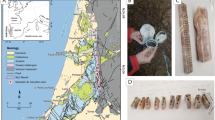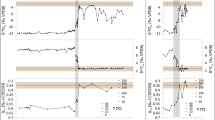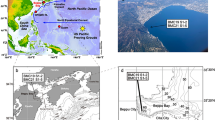Abstract
CALCITE deposits in caves, known as speleothem, can provide valuable palaeoenvironmental information1–4. In particular, because speleothem are deposited only in air-filled caves, gaps in deposition in coastal caves record high-stands of sea level. Here we report the use of isotope-dilution mass spectrometry to date speleothem by the uranium-series method. The use of mass spectrometry in uranium-series dating was first applied to corals5, and has greatly improved the precision of this dating method. The speleothem dated here—a flowstone from 15 m below modern sea level in a Bahamian cave—records changes in sea level over the past 280,000 years. The dated hiatuses in deposition indicate high sea-level stands that are in general agreement with data from deep-sea oxygen isotope stratigraphy6 and other estimates for the timing of high-stands and glacial minima1–3,7.
This is a preview of subscription content, access via your institution
Access options
Subscribe to this journal
Receive 51 print issues and online access
$199.00 per year
only $3.90 per issue
Buy this article
- Purchase on Springer Link
- Instant access to full article PDF
Prices may be subject to local taxes which are calculated during checkout
Similar content being viewed by others
References
Harmon, R. S., Schwarcz, H. P. & Ford, D. C. Quat. Res. 9, 205–218 (1978).
Gascoyne, M., Benjamin, G. J., Schwarcz, H. P. & Ford, D. C. Science 205, 806–808 (1979).
Harmon, R. S. et al. Nature 289, 481–483 (1981).
Schwarz, H. P. in Handbook of Environmental Geochemistry. The Terrestrial Environment Part B (eds Fritz, P. & Fontes, J.-C.) 271–303 (Elsevier, Amsterdam, 1986).
Edwards, R. L. et al. Earth planet. Sci. Lett. 81, 175–192 (1986/87).
Imbrie, J. et al. in Milankovitch and Climate (eds Berger, A. L. et al.) 269–305 (Reidel, Dordrecht, 1984).
Harmon, R. S. et al. Palaeogeog. Palaeoclimat. Palaeoecol. 44, 41–70 (1983).
Ivanovich, M. & Harmon. R. S. (eds) Uranium Series Disequilibrium (Oxford University Press, New York, 1982).
Winograd, I. J., Szabo, B. J., Coplan, T. B. & Riggs, A. C. Science 242, 1275–1280 (1988).
Chappell, J. & Shackleton, N. J. Nature 324, 137–140 (1986).
Mylroie, J. E. & Carew, J. L. Quat. Sci. Rev. 7, 55–64 (1988).
Gascoyne, M., Ford, D. C. & Schwarcz, H. P. Earth Surface Processes and Landforms 8(6), 557–568 (1983).
Harmon, R. S., Ku, T.-L., Matthews, R. K. & Smart, P. L. Geology 7, 405–409 (1979).
Emiliani, C. J. Geology 63, 538–578 (1955).
Author information
Authors and Affiliations
Rights and permissions
About this article
Cite this article
Li, WX., Lundberg, J., Dickin, A. et al. High-precision mass-spectrometric uranium-series dating of cave deposits and implications for palaeoclimate studies. Nature 339, 534–536 (1989). https://doi.org/10.1038/339534a0
Received:
Accepted:
Issue Date:
DOI: https://doi.org/10.1038/339534a0
This article is cited by
-
Fuzzy-based spatial modeling approach to predict island karst distribution: a conceptual model
Environmental Earth Sciences (2014)
-
Magnetostratigraphy and fold tests from Račiška pečina and Pečina v Borštu caves (Classical Karst, Slovenia)
Studia Geophysica et Geodaetica (2010)
-
Phasing and amplitude of sea-level and climate change during the penultimate interglacial
Nature Geoscience (2009)
Comments
By submitting a comment you agree to abide by our Terms and Community Guidelines. If you find something abusive or that does not comply with our terms or guidelines please flag it as inappropriate.



